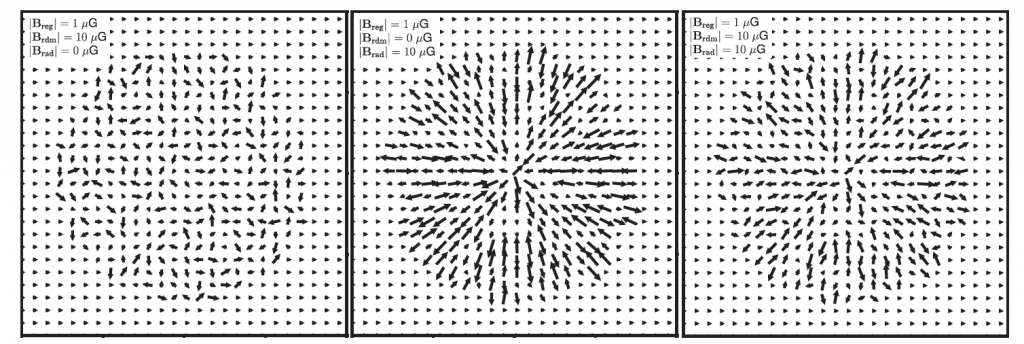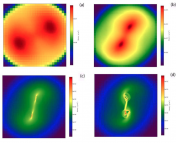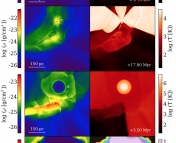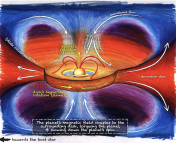Authors: J. L. West, T. Jaffe, G. Ferrand, S. Safi-Harb, and B. M. Gaensler
First Author’s Institution: Dunlap Institute for Astronomy and Astrophysics at the University of Toronto, Canada
Status: Published in Astrophysical Journal Letters, open access on arXiv
In the roiling outer layers of exploding stars, electrons are accelerated to near light speed. These relativistic electrons have a habit of causing glitches in orbiting spacecraft and sparking showers of secondary particles. Striking the retinae of in-orbit astronauts, they generate flashes of phantom light.
How do these electrons reach their enormously high velocities? The exact mechanism isn’t known, but it’s thought to depend upon the magnetic fields threaded throughout the expanding shells of young supernova remnants. Curiously, as shown in Figure 1, many young supernova remnants appear to have well-ordered radial magnetic fields, pointing neatly away from or toward the center of the explosion. While it’s not impossible for the magnetic field to be orderly, it’s reasonable to expect that the explosion of a dying star, which creates swirling knots and curlicues of hot plasma, would impart some turbulence and randomness to its magnetic field. Could the neat, radial pattern that we observe belie the true, messy magnetic field? If so, how can we tell?

Figure 1. Magnetic field magnitude (shown by the contours) and direction for the four young supernova remnants studied in the paper. Click to enlarge. Adapted from Figure 1 in the paper.
To answer these questions, the authors use a three-dimensional model of the magnetic fields in young supernova remnants. To begin, the authors assigned each point in a three-dimensional grid a magnetic field strength and direction. As shown in Figure 2, they considered three combinations of magnetic field components. All three cases include a small, uniform component that represents the background Galactic magnetic field that is compressed as the supernova remnant expands. On top of the uniform component, the authors add either a radial component, a random, turbulent component, or both.

Figure 2. Three magnetic field conditions, shown as two-dimensional slices through the center of the modeled supernova remnant. From left to right: Turbulence-dominated, radially-dominated, and equal contributions from turbulent and radial components. Figure 2 in the paper.
In addition to the three magnetic field orientations, the authors also consider three different mechanisms to accelerate the electrons to relativistic velocities:
- Isotropic: Electron acceleration doesn’t depend on which way the magnetic field is oriented
- Quasi-parallel: Electrons are accelerated more efficiently when the magnetic field is parallel to the supernova remnant’s outward motion
- Quasi-perpendicular: Electrons are accelerated more efficiently when the magnetic field is perpendicular to the supernova remnant’s outward motion
Combining the magnetic field model with the acceleration mechanisms gives two-dimensional maps of what we would see if we could observe the modeled supernova remnants. As shown in Figure 3, the authors find that both the quasi-parallel and quasi-perpendicular acceleration mechanisms can create (apparent) order out of chaos; quasi-parallel acceleration produces an apparently radial field, while quasi-perpendicular acceleration yields an apparently tangential field. This happens due to a kind of selective amplification; even if electrons are distributed evenly throughout, they will be preferentially accelerated by certain magnetic field orientations and not by others. In the case of quasi-parallel acceleration, electrons become relativistic only where the magnetic field is radial.

Figure 3. Simulated polarized intensity (color scale) and simulated magnetic field orientations (black lines) for a turbulent intrinsic field and three different acceleration mechanisms. Although the isotropic electron acceleration mechanism (left) yields an apparently random magnetic field, the quasi-parallel (center) and quasi-perpendicular (right) acceleration mechanisms generate apparently ordered magnetic fields. Adapted from Figure 4 in the paper.
Since what we actually measure is the synchrotron radiation emitted by relativistic electrons spiraling around magnetic field lines, this means that we’ll see the most emission where the magnetic field is radial (in the case of quasi-parallel acceleration, at least). The tricky bit lies in the fact that the emission is polarized perpendicular to the magnetic field—so the magnetic field direction is inferred from the way the synchrotron emission is polarized. (You can learn more about polarization and its uses in this Astrobite.) This is where the sleight of hand happens—if relativistic electrons are only created where the magnetic field points a certain way, the inferred magnetic field will be different from the magnetic field that is actually there!
This result implies that an apparently radial magnetic field can arise from a radial field or a random field. How can we tell whether the magnetic field is really well-ordered and radial or more random? The answer may lie in measuring the ratio of polarized to unpolarized light, also known as the fractional polarization. Figure 4 shows that the fractional polarization is much higher in the case of a radial field than in the case of a random field. Although this is a delicate measurement to make—the intervening interstellar medium tends to reduce the fraction of polarization—this is a possible avenue for determining the elusive mechanism through which relativistic electrons are generated.

Figure 4. Mean (black) and maximum (red) fractional polarization calculated for 20 bins across the modeled supernova remnants. The fractional polarization is substantially higher when the magnetic field is radial. Adapted from Figure 5 in the paper.
Featured Image: Tycho’s supernova remnant as seen by the Chandra X-ray Observatory. Credits: X-ray: NASA/CXC/Rutgers/K.Eriksen et al.; Optical (background stars): DSS





Trackbacks/Pingbacks